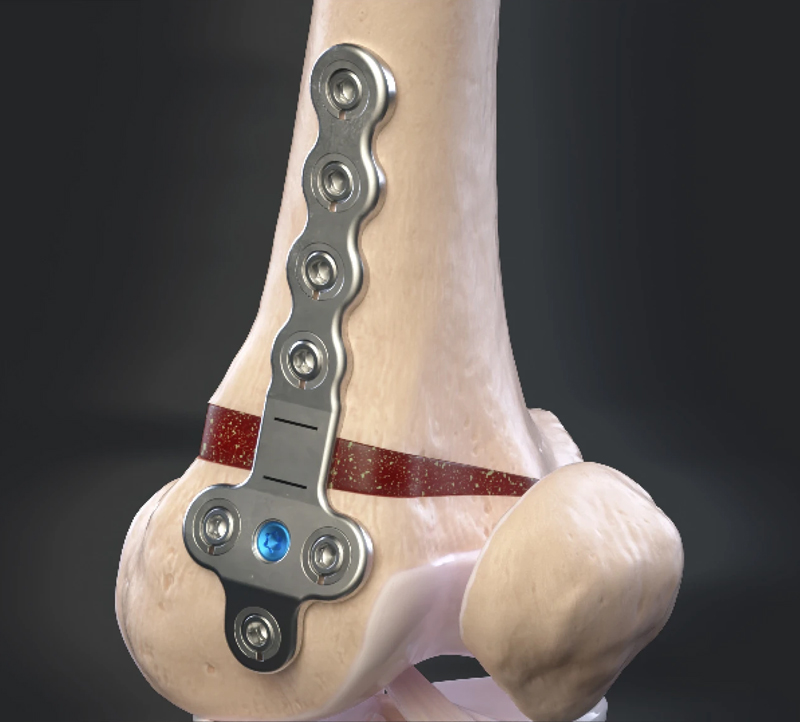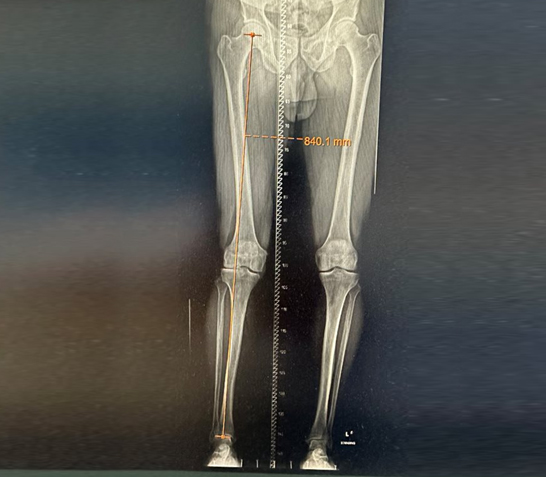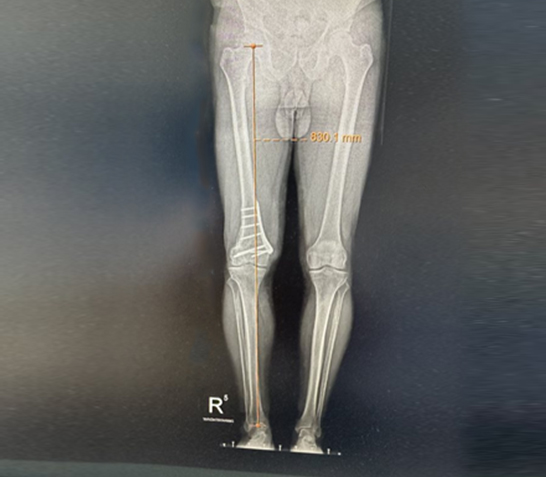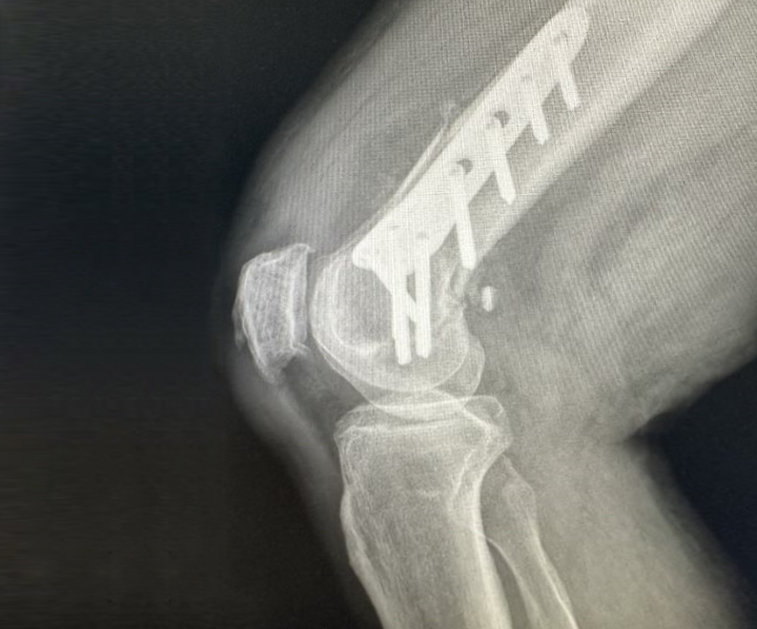
What is Distal Femoral Osteotomy (DFO)
DFO is a limb deformity surgery which is best suited for lateral compartment osteoarthritis (OA) of the knee. Lateral compartment OA of the knee is not very common unlike the medial compartment OA (most common) of the knee. In Lateral compartment OA of knee, the outer side (lateral compartment) of the knee is worn out, while the rest of the knee (medial compartment and patello-femoral joint) are usually well preserved. Since your knee joint is retained, unlike a knee replacement, you can continue to participate in high intensity sporting activities with no restriction. This is a specialist knee surgery which only a few surgeons in UK undertake regularly and Mr. Ellapparadja is one among them. He has undergone a BOA accredited Osteotomy Knee fellowship where he learnt the principles and surgical skills of performing a knee osteotomy to high standards.
Biomechanics of knee joint regarding DFO
Normally most of us, especially men, are bowlegged, meaning the weight bearing line of the leg (this is represented by a line joining the centre of the hip to centre of ankle joint) passes through the medial compartment of the knee, thereby the medial compartment takes more of our body weight when comparted to the lateral compartment (see Fig 1). However, in lateral compartment OA of the knee, the weight bearing line passes through the lateral compartment leading to damage and progressive degeneration of this part of the knee. . DFO is essentially a realignment procedure where the knee is realigned to bear more weight through the medial compartment of the knee while the worn-out lateral compartment is relatively spared of the weight bearing function thereby leading to pain relief (this is like the saying ‘Robbing Peter to pay Paul’) – see Fig 2.
Who should be offered DFO?
Originally, this procedure was offered only for younger patients who would like to preserve their knee and continue to enjoy sporting activities. However, age is definitely not a barrier and current evidence show that osteotomy is successful in older age group if they fulfil the necessary criteria. This surgery is also suitable for people like scaffolders and joiners who lift heavy weight as part of their job. Lifting heavy weights is usually not advisable after a knee replacement
Clinical Symptoms
The patients usually present with lateral side joint pain and inability to walk along with stiffness of the knee (Knock Knee). The knee often swells up after walking or other strenuous activities. The knee may also lock or give way. It is quite often difficult to perform sporting activities such as running or walking long distances. Once you come to the clinic, you will undergo physical examination and investigations including weight bearing long leg films. The long leg film is essential to confirm that you are predominantly weight bearing through the lateral compartment of the knee. Further, MRI of the knee is needed to ascertain the intactness of the cartilage in the other compartments of the knee which is usually obtained either on the same day or on a later date. Once the diagnosis is confirmed, then the various treatment options will be discussed with you.

Fig 1 - Before DFO surgery

Fig 2 - After DFO surgery
Non-Operative Treatment
This option is usually tried in the form analgesics (paracetamol & ibuprofen) and physiotherapy. This may be helpful in the initial stages, however, once the disease process is advanced, surgical management will provide better pain relief. Further, a lateral compartment off loader knee brace is given to the patient, (which will simulate the surgery effect) and often provides better pain relief by pushing the leg into varus alignment thereby taking the pressure of the damaged lateral compartment. This brace may predict the extent of pain relief that might be achieved by the osteotomy procedure
How the DFO surgery is performed
DFO is usually performed under general anaesthesia (patient is fully asleep) or under spinal anaesthesia (patient is generally awake and is numb down the waist). The procedure is done under X-ray control and a tourniquet is generally used to control the bleeding. A small cut is made on the inner side of the thigh just above the knee joint. An oblique cut is made into the femur (thigh bone), and a triangular wedge of bone is removed and the gap is closed until the desired correction is achieved. This desired correction is calculated from the long leg films taken preoperatively. Once the desired correction is achieved, this is held in place with a plate and screws. The soft tissues and skin are closed, and a pressure bandage is applied.
Enhanced Recovery /Day Case Surgery
Mr. Ellapparadja is a very keen proponent of enhanced recovery and often aims to carry out procedures like DFO as a day case procedure. The Local anaesthetic injections given around the knee at the time of surgery provide good pain relief for around 12 hours after surgery. Early mobilisation of the patient is encouraged with in the first 2 hours of returning to ward. Patient can start weight bearing as tolerated with crutches. Patient can go home the same evening if they are deemed to be safe for discharge failing which they are discharged the next day.
Recovery
Once discharged from the hospital, the first 2 weeks are crucial in recovering from surgery. It is essential to keep the knee moving aiming for a range of movements from 0° to 90° of flexion. Though weight bearing as able with crutches is permitted, please do not overdo things and do only the essential walking such as walking with in the house. You will be prescribed with blood thinners for the first 2 weeks after surgery (usually Aspirin or Apixaban) to minimise the risk of clot formation.
The skin sutures/clips will be usually removed at the GP in 2 weeks’ time. It is quite common for the knee to swollen, appear a bit inflamed and remain warm for the first few weeks after the surgery. However, if there is any bleeding from the wound, pus discharge or significant swelling associated with fever and unwellness, it is essential that you seek medical attention immediately to rule out infection.
Physiotherapy team will continue to work with you in the recovery period to improve the strength in your muscles and increase the range of motion of the knee. Return to sporting activities usually is around 4-6 months’ time when the bone is completely healed.
During your consultation, you will be asked if you would like to consent for your information to be put into the UKKOR. UKKOR refers to United Kingdom Knee Osteotomy registry website which is similar to NJR (national joint registry) for Hip and Knee replacements. Mr. Ellapparadja is very keen to input his patient’s data into UKKOR to help create a large database of osteotomy patients in UK which will give valuable information regarding osteotomy surgery and its outcome. Once you have consented to participate in UKKOR, you will be regularly contacted through email both before and after surgery to fill in PROMS data (Patient Reported Outcome Measure).
Complications
There are a few complications that can happen after DFO surgery, most important being infection, clot in legs/lungs. delayed bone healing & wound healing problems. If the infection is deemed superficial, it can be treated with oral antibiotics, however deeper infection may merit debridement of the surgical wound. You will receive blood thinners for the first 2 weeks after surgery and you should take them without fail. Further, keeping yourself mobile by walking within the house prevents the stagnation of blood. Delayed bone and wound healing are often a problem, especially if you are a smoker and it is essential that you stop smoking at least for 2-3 months before surgery and continue to remain non-smoking until the bone has completely healed.

SIDE VIEW OF DFO PLATE FIXATION
